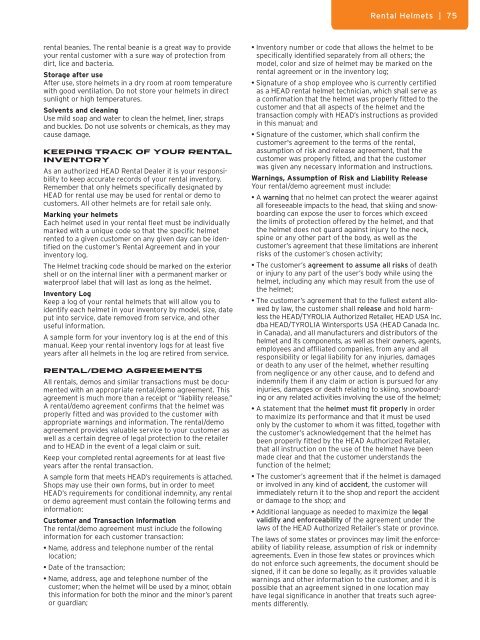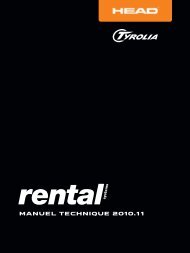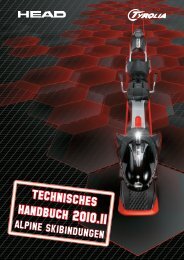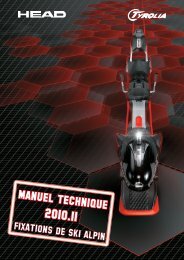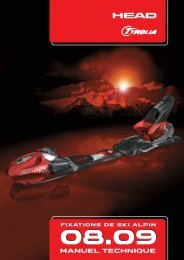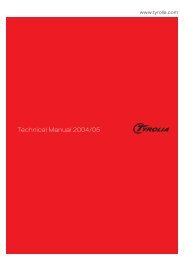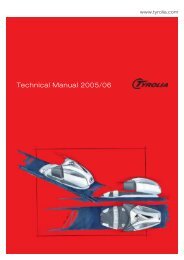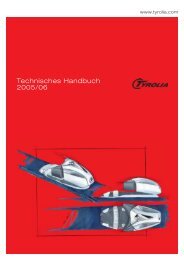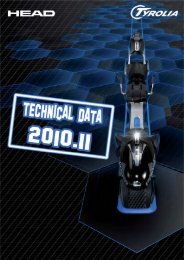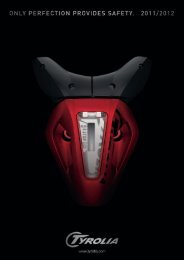You also want an ePaper? Increase the reach of your titles
YUMPU automatically turns print PDFs into web optimized ePapers that Google loves.
ental beanies. The rental beanie is a great way to provide<br />
your rental customer with a sure way of protection from<br />
dirt, lice and bacteria.<br />
Storage after use<br />
After use, store helmets in a dry room at room temperature<br />
with good ventilation. Do not store your helmets in direct<br />
sunlight or high temperatures.<br />
Solvents and cleaning<br />
Use mild soap and water to clean the helmet, liner, straps<br />
and buckles. Do not use solvents or chemicals, as they may<br />
cause damage.<br />
Keeping Track of Your Rental<br />
Inventory<br />
As an authorized HEAD Rental Dealer it is your responsibility<br />
to keep accurate records of your rental inventory.<br />
Remember that only helmets specifically designated by<br />
HEAD for rental use may be used for rental or demo to<br />
customers. All other helmets are for retail sale only.<br />
Marking your helmets<br />
Each helmet used in your rental fleet must be individually<br />
marked with a unique code so that the specific helmet<br />
rented to a given customer on any given day can be identified<br />
on the customer’s Rental Agreement and in your<br />
inventory log.<br />
The Helmet tracking code should be marked on the exterior<br />
shell or on the internal liner with a permanent marker or<br />
waterproof label that will last as long as the helmet.<br />
Inventory Log<br />
Keep a log of your rental helmets that will allow you to<br />
identify each helmet in your inventory by model, size, date<br />
put into service, date removed from service, and other<br />
useful information.<br />
A sample form for your inventory log is at the end of this<br />
manual. Keep your rental inventory logs for at least five<br />
years after all helmets in the log are retired from service.<br />
Rental/Demo Agreements<br />
All rentals, demos and similar transactions must be documented<br />
with an appropriate rental/demo agreement. This<br />
agreement is much more than a receipt or “liability release.”<br />
A rental/demo agreement confirms that the helmet was<br />
properly fitted and was provided to the customer with<br />
appropriate warnings and information. The rental/demo<br />
agreement provides valuable service to your customer as<br />
well as a certain degree of legal protection to the retailer<br />
and to HEAD in the event of a legal claim or suit.<br />
Keep your completed rental agreements for at least five<br />
years after the rental transaction.<br />
A sample form that meets HEAD’s requirements is attached.<br />
Shops may use their own forms, but in order to meet<br />
HEAD’s requirements for conditional indemnity, any rental<br />
or demo agreement must contain the following terms and<br />
information:<br />
Customer and Transaction Information<br />
The rental/demo agreement must include the following<br />
information for each customer transaction:<br />
• Name, address and telephone number of the rental<br />
location;<br />
• Date of the transaction;<br />
• Name, address, age and telephone number of the<br />
customer; when the helmet will be used by a minor, obtain<br />
this information for both the minor and the minor’s parent<br />
or guardian;<br />
Rental Helmets | 75<br />
• Inventory number or code that allows the helmet to be<br />
specifically identified separately from all others; the<br />
model, color and size of helmet may be marked on the<br />
rental agreement or in the inventory log;<br />
• Signature of a shop employee who is currently certified<br />
as a HEAD rental helmet technician, which shall serve as<br />
a confirmation that the helmet was properly fitted to the<br />
customer and that all aspects of the helmet and the<br />
transaction comply with HEAD’s instructions as provided<br />
in this manual; and<br />
• Signature of the customer, which shall confirm the<br />
customer's agreement to the terms of the rental,<br />
assumption of risk and release agreement, that the<br />
customer was properly fitted, and that the customer<br />
was given any necessary information and instructions.<br />
Warnings, Assumption of Risk and Liability Release<br />
Your rental/demo agreement must include:<br />
• A warning that no helmet can protect the wearer against<br />
all foreseeable impacts to the head, that skiing and snowboarding<br />
can expose the user to forces which exceed<br />
the limits of protection offered by the helmet, and that<br />
the helmet does not guard against injury to the neck,<br />
spine or any other part of the body, as well as the<br />
customer’s agreement that these limitations are inherent<br />
risks of the customer’s chosen activity;<br />
• The customer’s agreement to assume all risks of death<br />
or injury to any part of the user’s body while using the<br />
helmet, including any which may result from the use of<br />
the helmet;<br />
• The customer’s agreement that to the fullest extent allowed<br />
by law, the customer shall release and hold harmless<br />
the HEAD/TYROLIA Authorized Retailer, HEAD USA Inc.<br />
dba HEAD/TYROLIA Wintersports USA (HEAD Canada Inc.<br />
in Canada), and all manufacturers and distributors of the<br />
helmet and its components, as well as their owners, agents,<br />
employees and affiliated companies, from any and all<br />
responsibility or legal liability for any injuries, damages<br />
or death to any user of the helmet, whether resulting<br />
from negligence or any other cause, and to defend and<br />
indemnify them if any claim or action is pursued for any<br />
injuries, damages or death relating to skiing, snowboarding<br />
or any related activities involving the use of the helmet;<br />
• A statement that the helmet must fit properly in order<br />
to maximize its performance and that it must be used<br />
only by the customer to whom it was fitted, together with<br />
the customer’s acknowledgement that the helmet has<br />
been properly fitted by the HEAD Authorized Retailer,<br />
that all instruction on the use of the helmet have been<br />
made clear and that the customer understands the<br />
function of the helmet;<br />
• The customer’s agreement that if the helmet is damaged<br />
or involved in any kind of accident, the customer will<br />
immediately return it to the shop and report the accident<br />
or damage to the shop; and<br />
• Additional language as needed to maximize the legal<br />
validity and enforceability of the agreement under the<br />
laws of the HEAD Authorized Retailer’s state or province.<br />
The laws of some states or provinces may limit the enforceability<br />
of liability release, assumption of risk or indemnity<br />
agreements. Even in those few states or provinces which<br />
do not enforce such agreements, the document should be<br />
signed, if it can be done so legally, as it provides valuable<br />
warnings and other information to the customer, and it is<br />
possible that an agreement signed in one location may<br />
have legal significance in another that treats such agreements<br />
differently.


